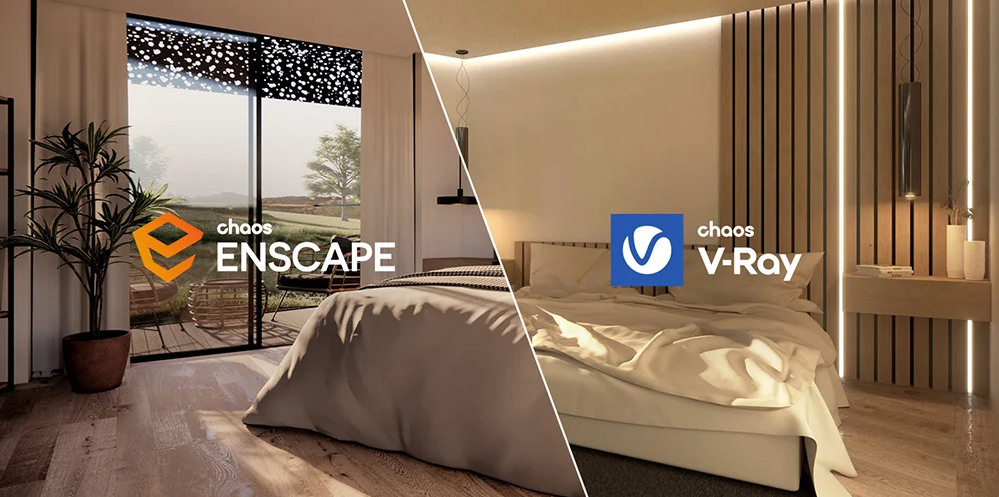V-RAY, ENSCAPE | V-Ray vs. Enscape: A Comprehensive Comparison for 3D Rendering in Architectural Visualization
Welcome to the world of architectural visualization, where the power of 3D rendering can bring your creative designs to life. As a 3D artist with a specialization in architectural visualization, I understand the importance of choosing the right rendering software. In this article, we'll dive deep into a comparison between two popular choices: V-Ray and Enscape.
Introduction
3D rendering is the magic wand that transforms your design concepts into photorealistic visuals. The choice of rendering software can significantly impact your workflow and the quality of your output. Whether you're an experienced 3D artist or just starting out, the decision between V-Ray and Enscape is crucial. Let's explore the aspects that matter most when making this choice.
Background
Before we plunge into the comparison, let's get to know our contenders.
V-Ray: The Industry Giant
V-Ray is not just a rendering engine; it's an industry giant that's been around for quite some time. Developed by Chaos Group, V-Ray is renowned for its exceptional rendering quality and flexibility. It's a go-to choice for professionals in architectural visualization, film, and design industries.
Enscape: The Real-Time Contender
Enscape, on the other hand, is a relatively new kid on the block, but it's making waves in the world of real-time rendering. It's known for its impressive speed and efficiency in creating real-time, interactive 3D visualizations. With its user-friendly approach, it's quickly becoming a favorite for architects and designers.
User Interface and Ease of Use
Your journey with any software starts with its user interface. Let's see how V-Ray and Enscape compare.
V-Ray: The Learning Curve
V-Ray's user interface may seem intimidating to beginners. Its plethora of settings and options can be overwhelming. However, if you're willing to invest time in learning, V-Ray can offer immense control and customization options, making it a favorite among seasoned professionals.
Enscape: User-Friendly Approach
Enscape shines in terms of user-friendliness. Its real-time interface is straightforward, and you can achieve impressive results with minimal effort. This simplicity makes it a fantastic choice for architects and designers who may not have extensive 3D rendering experience.
Personal Anecdote: I remember the first time I tried V-Ray. I was fascinated by the possibilities it offered but slightly overwhelmed by the sheer number of settings. However, with practice and online resources, I mastered it. Enscape, on the other hand, felt like a breeze right from the start. It's a matter of personal preference and your specific needs.
Rendering Quality
As a 3D artist, the quality of your renderings is paramount. Let's see how V-Ray and Enscape measure up in this aspect.
V-Ray: The Benchmark for Realism
V-Ray is renowned for its exceptional rendering quality. It excels in creating realistic scenes with intricate lighting and materials. The subtlety and accuracy in V-Ray's renderings make it a preferred choice for architectural visualization when realism is a top priority.
Enscape: Real-Time Brilliance
Enscape, although real-time, doesn't fall short in rendering quality. It offers impressive realism for quick presentations and design iterations. However, it might not reach the same level of photorealism as V-Ray, but it's more than sufficient for most architectural visualization projects.
Rendering Speed and Performance
The speed of rendering is a critical factor, especially when meeting tight project deadlines.
V-Ray: Patience Pays Off
V-Ray is known for its attention to detail, but this often comes at the cost of rendering time. The complex calculations it performs can result in longer rendering times, requiring patience and powerful hardware for efficient operation.
Enscape: The Need for Speed
Enscape's real-time rendering capabilities shine in this department. It offers near-instant feedback on changes, making it a fantastic choice for design reviews and client presentations. Its efficiency reduces the waiting time for results significantly.
Personal Anecdote: I once had a project with an urgent deadline. I decided to use Enscape for its speed, and I was able to showcase multiple design iterations to the client in real-time, which impressed them greatly. However, for the final presentation, I switched to V-Ray to ensure the highest quality output.
Real-time Rendering Capabilities
In the age of real-time visualization, this aspect can't be overlooked.
V-Ray: Near Real-Time With V-Ray Vision
V-Ray has stepped up its real-time game with "V-Ray Vision." While it may not match the instant feedback of Enscape, it allows you to interactively adjust materials and lighting in the viewport, offering a blend of speed and quality.
Enscape: Real-Time Interactivity
Enscape's real-time interactivity is its hallmark. With Enscape, you can effortlessly navigate your 3D scenes, adjusting lighting and materials in real-time. It's a game-changer for design presentations and collaborations.
Workflow Integration
Your rendering software needs to seamlessly integrate with your 3D modeling and CAD software.
V-Ray: The Industry Standard
V-Ray boasts excellent integration with popular software like SketchUp, 3ds Max, and Rhino. It's considered an industry standard, and you'll find plenty of resources and plugins to enhance your workflow.
Enscape: Efficient Integration
Enscape is no slouch in this department either. It seamlessly integrates with leading software such as SketchUp, Revit, and ArchiCAD. Its efficiency in data transfer and real-time updates within the host software streamlines the design process.
Personal Anecdote: I remember a project where I had to collaborate with a team using different 3D software. V-Ray's compatibility with multiple platforms made the transition between applications smoother. On the flip side, for a solo project, I found Enscape's real-time integration a time-saving blessing.
Customization and Flexibility
The ability to customize materials and lighting is essential for creating unique visualizations.
V-Ray: Limitless Customization
V-Ray offers extensive options for customization. You can create highly detailed materials, control lighting down to the minute details, and even utilize scripting for advanced workflows. If you're a control enthusiast, V-Ray has you covered.
Enscape: Streamlined Efficiency
Enscape, while not as in-depth in terms of customization, offers a streamlined approach. It simplifies the process by providing pre-set materials and lighting options, making it quick and efficient for architectural visualization.
Cost and Licensing
Your budget plays a pivotal role in your software choice.
V-Ray: The Investment
V-Ray, being an industry heavyweight, comes with a price tag. Its licensing models can range from subscriptions to perpetual licenses, catering to individual freelancers and large studios. However, it's an investment that pays off in terms of rendering quality and versatility.
Enscape: Budget-Friendly
Enscape offers a more budget-friendly pricing model. It primarily operates on a subscription basis, making it accessible to a broader audience. This affordability is appealing to individual artists and smaller design firms.
Support and Community
Access to support and a thriving user community can be a lifesaver when you encounter issues or need advice.
V-Ray: Robust Support
V-Ray has a well-established user community and extensive documentation. Technical support is readily available, ensuring you can find solutions to most problems you encounter.
Enscape: Growing Community
Enscape's community is rapidly expanding. While it may not have the same vast resources as V-Ray, it's growing steadily, and the Enscape team is actively engaged with users, providing assistance and updates.
Conclusion
So, which one should you choose? It all boils down to your specific needs and preferences.
If you value meticulous control, supreme rendering quality, and are willing to invest time and effort, V-Ray is the classic choice.
On the other hand, if you require speed, ease of use, and real-time interactivity for design presentations, Enscape is a fantastic option.
As for me, I've found that having both V-Ray and Enscape in my toolkit offers the best of both worlds. I use V-Ray for high-quality final presentations and Enscape for design reviews and quick client meetings. The versatility of using both ensures I'm well-prepared for any project that comes my way.
Final Thoughts
The world of 3D rendering and architectural visualization is evolving at a rapid pace. New software options continue to emerge, pushing the boundaries of what's possible. Whether you choose V-Ray, Enscape, or a combination of both, keep an eye on the exciting trends and innovations in the field. Your choices today will shape the stunning visualizations of tomorrow. Happy rendering!














